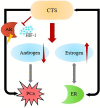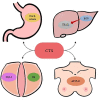Research Progress in Pharmacological Activities and Applications of Cardiotonic Steroids
- PMID: 35721110
- PMCID: PMC9205219
- DOI: 10.3389/fphar.2022.902459
Research Progress in Pharmacological Activities and Applications of Cardiotonic Steroids
Abstract
Cardiotonic steroids (CTS) are a group of compounds existing in animals and plants. CTS are commonly referred to cardiac glycosides (CGs) which are composed of sugar residues, unsaturated lactone rings and steroid cores. Their traditional mechanism of action is to inhibit sodium-potassium ATPase to strengthen the heart and regulate heart rate, so it is currently widely used in the treatment of cardiovascular diseases such as heart failure and tachyarrhythmia. It is worth noticing that recent studies have found an avalanche of inestimable values of CTS applications in many fields such as anti-tumor, anti-virus, neuroprotection, and immune regulation through multi-molecular mechanisms. Thus, the pharmacological activities and applications of CTS have extensive prospects, which would provide a direction for new drug research and development. Here, we review the potential applications of CTS in cardiovascular system and other systems. We also provide suggestions for new clinical practical strategies of CTS, for many diseases. Four main themes will be discussed, in relation to the impact of CTS, on 1) tumors, 2) viral infections, 3) nervous system diseases and 4) immune-inflammation-related diseases.
Keywords: antitumor; antiviral; cardiotonic steroids (CTS); immune regulation; neuroprotection.
Copyright © 2022 Ren, Gao, Guo, Wang and Wang.
Conflict of interest statement
The authors declare that the research was conducted in the absence of any commercial or financial relationships that could be construed as a potential conflict of interest.
Figures






References
Publication types
LinkOut - more resources
Full Text Sources
Research Materials

